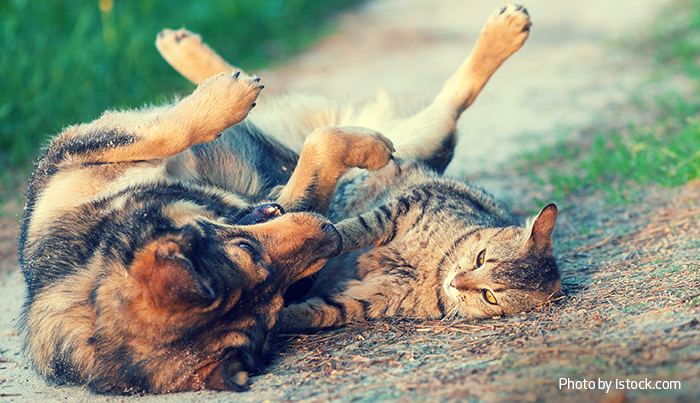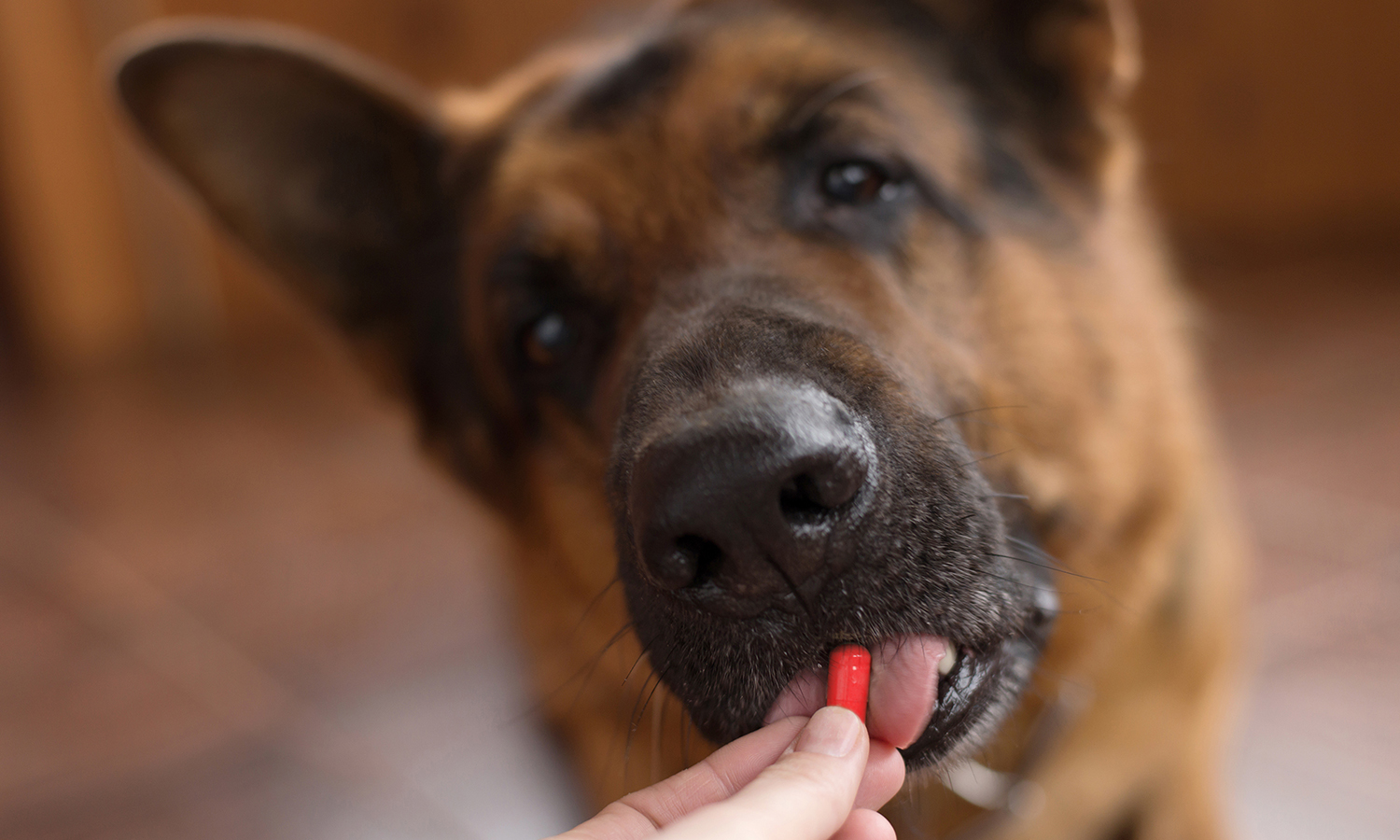
Thinking about getting a buddy for your German Shepherd, but your yard is not big enough to add another dog? Or maybe an opportunity to get a German Shepherd puppy has presented itself and you don’t know if your cat, Max, can adjust?
Introducing your cat to a German Shepherd, or vice versa, doesn’t have to be hard. There are things you can do—and not do—to make the introduction easier.
The Basics
If you are bringing a cat into your German Shepherd’s home, make sure the cat can run and hide should it want to. Cats and kittens need to be able to move freely, and confidently, especially during the introduction period. The ideal situation is to establish a dog-free zone for your new cat. Give it time to adjust and become comfortable in it’s new environment. When it comes time to introduce the cat to your German Shepherd, have something for the cat to perch on or hide in that is elevated off the floor. This gives the cat confidence and can allow it time to relax and observe.
You should also make sure your dog is restrained, securely, inside a crate or behind a baby gate. Your German Shepherd must not be allowed to chase the cat. German Shepherds are herding dogs and many have strong prey drives that are genetically bred into them. Because prey drive is innate and something they are born with, a dog might be able to contain its drive, but it can almost never be trained out of a dog. A German Shepherd with a strong prey drive can be dangerous around small animals—especially if they attempt to run or move quickly.
Sometimes, introductions go extremely well and your German Shepherd and cat hit it off immediately. But it is more likely to take days or even weeks for the acclimation process to play out. And it is okay if they don’t have an amazing relationship as long as there is mutual understanding and respect. But if you come home to find one of them cowering in fear—one is continuously hiding—seek the advise of a professional trainer or better yet, a veterinary behaviorist. If your German Shepherd begins displaying newl behaviors like resource guarding (snarling, growling or snapping around its food or toys) or being aggressive toward your cat, get help. Do not wait until someone gets hurt—or worse.
Sometimes introductions go extremely well and there is an instant connection. But most often, introductions take days or even weeks. So patience is key.

Common Introduction Mistakes
Forced physical contact. Picking up your new kitty and holding it to your German Shepherd’s face is one of the most common mistakes people make when introducing cats and dogs. We can assure you that this is the fastest way to tempt your cat to hiss and scratch a dog—and encourage your dog to dislike or fear cats. Always let a cat or kitten decide when or if it is ready to approach a dog.
Making temperament assumptions about foster or rescue animals. Not knowing the background of the dog or cat that you adopt can make the introduction process more risky. When an animals’ prior life experiences or reactions are unknown, surprises—both good or bad—can happen. Extra precautions and extended, supervised introductions are usually required until behaviors become more predictable.
Preparing your house—but not your current pet—for the new arrival. Many animals, like people, do not like change. When preparing for the arrival of a new pet, introduce small changes to your pet’s routines. Purchase a baby gate and install it in different locations around the house. Close doors that you don’t normally close. Move their feeding bowl and bedding to different locations. Making these small, impromptu changes teaches your pet expect change and accept it.

Tips for Improving Dog and Cat Relationships
Before Kitty Arrives….
Train your dog. The best way to set your German Shepherd up for success with cats is to teach them to control their impulses. Dog’s are much more adaptable and trainable than cats, so ensuring your dog has a solid foundation of obedience greatly increase your chances of a successful dog/cat relationship. Delay the arrival of kitty, if needed, until you are confident that your German Shepherd understands fully the basics of obedience. Sign up for a local obedience class as a refresher, if needed—which leads us to the next tip….
Take personality, health and age into consideration. Understanding fully the personality and needs of your current pet is crucial. If your German Shepherd is aggressive and/or territorial, introducing a skittish cat with similar characteristics could be a formula for disaster. Likewise, an older, arthritic German Shepherd might not be willing to share its space with a rambunctious, playful kitten. Before bringing any new pet into your home, have a backup plan in place should there be an incompatibility issue. Consider arranging your home so that your dog and cat can be kept separated—for the long term.
Give your kitty a space of its own. Cats need to feel safe and protected and should have a space in your home that is off-limits to the dog. You should also have safe spaces scattered throughout the house so your cat can move freely, relatively undisturbed. And since cats are natural climbers, take advantage of your home’s vertical space. Purchase cat towers or install accessible shelves with a cat bed. This allows your cat to observe your German Shepherd from a safe distance. Place your cat’s litter box in a location that is not dog accessible. If your cat is not comfortable with using its litter box, it might find other, less suitable locations. Plus, dogs are notorious for snacking on cat poop—a habit that can lead to intestinal parasites and big vet bills for you.
Plan the first meeting carefully. Just like humans, cats and dogs have just one good chance to make a great first impression. Luckily, they both love food, which might ultimately help them love each other. Schedule the first cat-dog meeting during mealtime, but keep the dog on a leash and both animals on opposite sides of a closed door. They won’t see each other, but they will smell each other while chowing down on their respective foods. They’ll begin to associate this smell with food, thus “making it a good thing,” Galaxy says. Do this every mealtime for several weeks, before slowly introducing visual simulation. Continue feeding the cat and dog separately, but on either side of a dog gate or screen, before finally removing it all together. By this point, “they’re eating side-by-side, pretty much ignoring each other,” Galaxy says. For safety’s sake, continue keeping the dog on a leash until you’re confident it’s safe to take it off (and even then, exercise caution).
When dogs and cats are raised together in loving, safe environments, they can become best buddies—or at the very least, they learn to tolerate one another.
After Kitty Arrives….
Keep all food and toys separate. The number one cause of pet aggression in the home is food and resource guarding, but the good news is there are simple things you can do to reduce the risk of unpleasant encounters. First, establish a feeding routine and feed at the same times each day. Second, do not free feed your pets (leave food out all day). Third, place your kitty’s food and water bowls out of reach for your dog—preferably in an elevated location. And lastly, keep a close eye on the cat’s toys. Not only can competition over toys prompt fighting but cat toys can pose choking risks and digestive issues in large-bred dogs like German Shepherds.
A tired German Shepherd is a happy German Shepherd. Most German Shepherds LOVE spending each and every secons with their humans. They are intelligent, energetic dogs that require lots of stimulation and exercise. If your German Shepherd is tired, it will be much less likely to become over stimulated by your cat—which can lead to harassment. Sign up for an obedience refresher course or other fun activity like rally obedience, trick training or even dock driving! Add new toys to their collection and institute play with your dog several times daily. If your find that you lack sufficient time for extra activities, hire a dog walker or look into doggy daycare as additional options for keeping your German Shepherd on the move.
And finally….





